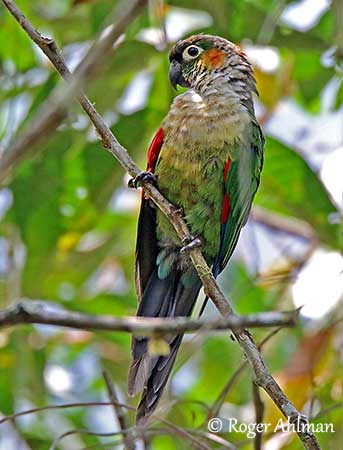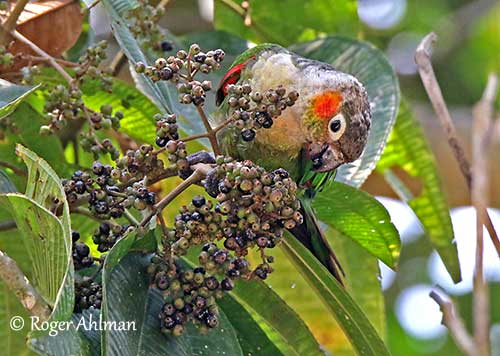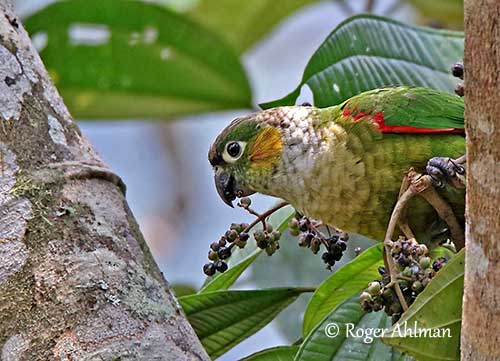
Fr: Conure à col blanc
Ang: White-breasted Parakeet - White-necked Parakeet
All: Weißhalssittich
Esp: Cotorra Cuelliblanca
Ita: Parrocchetto collobianco
Nd: Witnekparkiet
Sd: vithalsad parakite
Photographer:
Roger Ahlman
Pbase Galleries Peru and Ecuador & My bird pictures on IBC
Text by Nicole Bouglouan
Sources :
HANDBOOK OF THE BIRDS OF THE WORLD vol 4 by Josep del Hoyo-Andrew Elliott-Jordi Sargatal - Lynx Edicions - ISBN: 8487334229
PARROTS OF THE WORLD – An Identification Guide – by Joseph M. Forshaw – Princeton University Press – ISBN 0691092516
Parrots: A Guide to Parrots of the World – Helm Identification Guides – By Mike Parr and Tony Juniper – Editeur: A& C Black, 2010 – ISBN: 1408135752, 9781408135754
BIRDS OF PERU by Thomas S. Schulenberg, Douglas F. Stotz, Daniel F. Lane, John P. O’Neill, Theodore A. Parker III–Princeton University Press 2007–ISBN: 978-0-691-13023-1
Parrots: Status Survey and Conservation Action Plan 2000-2004 by Noel F. R. Snyder – Editeur: IUCN, 2000 – ISBN: 2831705045, 9782831705040
Neotropical Birds – Cornell Lab of Ornithology
Wikipedia, la enciclopedia libre
World Land Trust - Saving threatened habitats worldwide
White-breasted Parakeet or White-necked Parakeet
Pyrrhura albipectus
Psittaciformes Order – Psittacidae Family
INTRODUCTION:
The White-breasted Parakeet is found in S Ecuador and N Peru where it lives in restricted range, in montane tropical forests.
It is usually seen in flocks, feeding high in the canopy, and sometimes near the ground where it searches for fruit, berries and flowers of various species.
The White-breasted Parakeet is threatened by trapping for cagebird trade, but also by habitat loss through continuous clearance of forest and extensive logging. The species is currently listed as Vulnerable.

DESCRIPTION OF THE BIRD:
Biometrics:
Length: 24 cm
Weight: 83 g
The White-breasted Parakeet adult has green upperparts and belly. The wings are green with blue primary flight-feathers and red primary coverts and carpal area. The tail is green and tipped dark brown, but mostly dull red below. Throat and breast are white with variable amount of pale yellow tinge. We can see a broad, white collar encircling the neck, merging into the yellowish breast on foreneck.
On the head, crown to nape are greyish-brown with pale grey fringes on nape. There is a thin, dark reddish-brown frontal band. The cheeks show yellow-and-green scaled pattern. The ear-coverts are yellow-orange.
The bill is greyish-brown. The eyes are brown, surrounded by bare, white eyering. Legs and feet are dark grey.
Male and female are similar.
The immature lacks the frontal band and the ear-coverts are paler than in adults. The breast is white.

RANGE:
The White-breasted Parakeet has restricted range in E slope of Andes in SE Ecuador (Morona-Santiago, Zamora-Chinchipe), and extreme N Peru (N Cajamarca).
HABITAT:
The White-breasted Parakeet occurs between 900 and 2,000 metres of elevation, but it is more common at 1,400/1,800 metres. It frequents the primary forest, including edges and adjacent clearings. However, it may tolerate slightly disturbed habitats, and sometimes frequents partly cleared areas.
It can be seen in the humid forest in upper tropical and subtropical areas, possibly preferring primary upland forest along watercourses.
CALLS AND SONGS: SOUNDS BY XENO-CANTO
The White-breasted Parakeet is often noisy. The flight call is a harsh, far-carrying “screeyr screeyr” often rapidly repeated, including by other members of the group. It also gives single “skee” or “week” while feeding.

BEHAVIOUR IN THE WILD:
The White-breasted Parakeet feeds on a variety of fruit from Ficus and other plant species. It also takes berries, and flowers of the liana Mikania leiostachya.
It usually forages high in trees in the upper stage to canopy, but it also comes near the ground where it can feed on favoured food plants.
The White-breasted Parakeet is usually found in small groups of 10-15 birds, but also in larger flocks of up to 50 birds. While feeding, they rapidly repeat the “skee” or “week” calls to create a noisy clamour prior to taking flight.
The breeding behaviour of this species is currently unknown.
The White-breasted Parakeet is probably resident.
The flocks are noisy and conspicuous when performing swift flight. While foraging in trees, they fly in small flocks in twisting flight through the canopy. They can be seen along regular routes every day, to and from their feeding areas.

REPRODUCTION OF THIS SPECIES:
There is no specific information on the breeding behaviour of the White-breasted Parakeet.
Copulation was observed in September. In captivity, the female lays up to 7 eggs.
PROTECTION / THREATS / STATUS:
The White-breasted Parakeet has restricted range. It is threatened by habitat destruction because the montane forest of E of Andes is continuously cleared. But subtropical forest in Podocarpus National Park and Cordillera del Cóndor are largely intact. Logging, illegal gold mining and human settlement occur even in National Park. Trapping for cagebird trade is an important threat too.
The population is roughly estimated at a few thousand birds, rounded to 1,500/7,000 mature individuals, and is slowly declining.
The White-breasted Parakeet is currently listed as Vulnerable.
